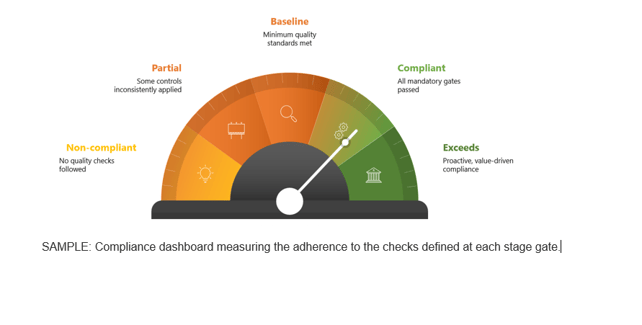Agile Is Not a Strategy—Structured Agility Is
Why This Matters
In today’s dynamic software development landscape, organizations are increasingly adopting Agile to boost speed and adaptability. However, this agility often comes at the expense of structured oversight, resulting in quality issues, misaligned dependencies, and unpredictable outcomes.
A strategic fusion of Agile and Stage-Gating offers a powerful solution. Agile fosters flexibility and iterative progress, while Stage-Gating introduces disciplined governance and clear decision checkpoints. When combined, they enable scalable, consistent, and high-quality delivery, proving that agility and structure can coexist.
Stage-Gating is often perceived as rigid and suited only for traditional waterfall models. But when reimagined as an enabler, it enhances clarity, quality, and control across any delivery framework.
In my experience implementing this in complex enterprise environments, Stage-Gating proves most valuable in three key scenarios:
- When Agile maturity varies across teams, from legacy waterfall to scaled Agile.
- In multi-vendor ecosystems, where coordination and accountability are critical.
- In non-digital-native organizations, where digital initiatives must align with core business operations without disruption.
Agile without guardrails can be chaos. Quality gates provide the balance needed for structured agility.
The Industry Challenge: Speed Without Structure Is Costing Enterprises Millions
As Agile adoption accelerates across industries, a familiar challenge is surfacing - teams are moving quickly, but not always in the right direction. The absence of cross-team governance is creating real consequences:
- Rework during enterprise Agile transformations can cost enterprises up to $2 million on average, often driven by unclear handoffs, undocumented decisions, and missing validation steps
(Source: Industry estimates; McKinsey research highlights similar risks and cost impacts). - According to PMI research, the majority of failed projects cite poor coordination, unclear ownership, and missed checkpoints as key drivers—rather than a lack of delivery speed.
(Source: PMI Pulse of the Profession, 2022–2023) - In regulated industries, audit failures stemming from undocumented stage transitions or approval gaps can lead to millions in fines or delays.
(Source: EY SOX Readiness Insights, 2022)
These risks are amplified in today’s complex delivery ecosystems. The issue isn’t Agile itself—it’s the lack of structured execution.
Systemic Challenges
- Maturity Mismatch: Teams operating at different Agile maturity levels often misalign on timelines, deliverables, and quality expectations.
- Diffused Accountability: In multi-team or multi-vendor models, ownership of scope, risk, and quality is often unclear.
- Unchecked Technical and Process Debt: Rapid delivery leads to skipped validations, whether in code, documentation, or compliance.
- Delayed Risk Visibility: Without structured checkpoints, critical risks are discovered too late, increasing remediation costs.
- Agile Misfit for Non-Tech Functions: Operational or non-software teams often struggle to interpret or scale Agile without contextual adjustments.
- Auditability Gaps in Regulated Sectors: For organizations governed by SOX, ISO, or HIPAA, missing documentation and approvals put compliance and reputation at risk.
Across these scenarios, one principle stands out: Agility must be underpinned by structure to scale effectively.
That’s where a tailored Stage-Gating model comes in - not as a bureaucratic hurdle, but as an adaptive governance framework. When thoughtfully implemented, it reinforces Agile delivery with shared accountability, consistent controls, and enterprise-grade discipline.
The Solution: Agile + Stage-Gating = Scalable & Predictable Execution
Many see Stage-Gating and Agile as opposing methodologies, but they complement each other.

Benefits of Quality (Stage) Gating
Quality gates are structured checkpoints that validate whether specific criteria are met before an initiative moves to the next phase. Each gate serves as a decision point, ensuring that processes are followed, risks are mitigated, and deliverables meet predefined standards.
- Prevention Over Correction: Detect defects early rather than fixing them post-production.
- Visibility into Agile Maturity: Helps teams assess their current process effectiveness and documentation handling.
- Alignment & Accountability: Ensures all stakeholders are aligned on deliverables and expectations.
- Governance & Compliance: Establishes clear, auditable checkpoints, ensuring regulatory and organizational compliance.
- Scalability to SAFe: Standardized quality controls enable smoother Agile scaling across teams.
- Governance without bureaucracy: Leadership has visibility while teams retain autonomy.
Why Combining Them Works
- Contextual Flexibility: Although Agile originated in software development, its core principles are universally applicable across industries.
- Phased Investment with Risk Control: Stage-Gate enables incremental funding and decision-making, helping mitigate financial and operational risks.
- Strategic vs. Tactical Focus: Stage-Gate operates at a macro level—guiding project selection and structure—while Agile focuses on micro-level execution through rapid iterations.
- Speed with Accountability: Agile drives faster delivery, while Stage-Gate ensures governance, risk oversight, and disciplined decision checkpoints.
- Harmonized Execution: Quality gates introduce structured oversight that complements Agile workflows, without compromising agility or innovation.
True agility isn’t just about speed – it’s about delivering the right value at the right time, with the right quality. When agile and governance work hand in hand, organizations don’t just move fast; they move forward with confidence.
Implementing Quality Gates: A Step-by-Step Approach
The true success of quality gates lies in how well they are customized to fit your organization's unique environment, not just in their existence. A rigid, one-size-fits-all approach can create bottlenecks, while a tailored framework ensures alignment with business objectives, development workflows, and risk appetite, ultimately driving efficiency and product excellence.
A Governance Framework ensures that quality gates are well-defined, enforced, and continuously improved. Here are the key components:
- Identify Key Transition Points: E.g., Requirements & Solutioning, Design & Architecture, Development & Testing, etc.
- Clearly Defined Gates & Objectives: Each phase must have a well-documented purpose and outcome.
- Standardized Checklists and Criteria: Each gate should have a predefined checklist that a Gate Steward validates before approving progression.
- Define Key Artifacts & Sign-Off Criteria: Ensure each phase meets predefined quality standards.

- Establish Gate Stewards or Guardians: To enforce quality, organizations must designate Gate Stewards who are responsible for validation at each checkpoint

- Auditability & Continuous Improvement: A governance framework should document outcomes and deviations at each gate, enabling auditability and process enhancements.

Overcoming Industry Challenges

Conclusion: A Blueprint for Scalable Execution Paving the Way for High-Quality, Scalable Delivery
Organizations that implement Agile with structured quality gating see:
- Faster time to market – Catching defects early reduces rework.
- Stronger vendor accountability – Standardized gates enforce common quality measures.
- Enhanced executive visibility – Leadership gains insights into quality checkpoints and risks.
- Improved cross-team collaboration – Clear exit criteria prevent bottlenecks and misalignment.
To truly mature Agile practices, organizations must go beyond ceremonies and frameworks, aligning governance with execution. Quality gates offer that missing link
- Drive agility without compromising governance
- Elevate quality across complex delivery ecosystems
- De-risk transformation across IT and non-IT functions
Ready to enable structured agility? Start by defining your quality gates - laying the foundation for scalable, predictable, high-quality outcomes.
Need help? Consult our Advisory & Transformation Services domain experts to learn more about measuring and improving agility using Coforge’s Agile Maturity Model.

Paramjoat Rajput is a Senior Consultant specializing in Advisory & Transformation Services at Coforge, with 15 years of experience in Business and IT Transformation, Program Management, and Agile Enablement. Has led enterprise-wide process transformations, driving Agile adoption, defining quality frameworks, and optimizing product delivery lifecycles. A certified SAFe Release Train Engineer (RTE) and PMP-trained professional, Paramjoat has played a key role in implementing structured quality gates and enabling scalable Agile practices for global clients. Her expertise extends to ERP/CRM systems, SDLC governance, and strategic transformation initiatives
Related reads.
About Coforge.
We are a global digital services and solutions provider, who leverage emerging technologies and deep domain expertise to deliver real-world business impact for our clients. A focus on very select industries, a detailed understanding of the underlying processes of those industries, and partnerships with leading platforms provide us with a distinct perspective. We lead with our product engineering approach and leverage Cloud, Data, Integration, and Automation technologies to transform client businesses into intelligent, high-growth enterprises. Our proprietary platforms power critical business processes across our core verticals. We are located in 23 countries with 30 delivery centers across nine countries.


